Nigerian Catfish stew is a simple Nigerian tomato stew made with catfish. It is delicious with the catfish giving it its distinctive rich flavour. Fresh catfish straight from the river is best for making this stew but frozen can also be used.
Catfish is a freshwater fish and is so-called because of the whiskers on its head which are called Barbels. It doesn’t have scales, it has firm flesh which makes it excellent for making this stew. Although you still need to be careful when handling and cooking it so that it will not break into bits.
Fish stew is generally my favourite kind of tomato stew and catfish stew is the best but other types of fish will taste just as good in this stew, each bringing its peculiar taste. So substitute Catfish with your favourite fish eg Tilapia, Haddock, Flounder, snapper, cod etc, they are all mildly flavoured and won’t overwhelm your stew.
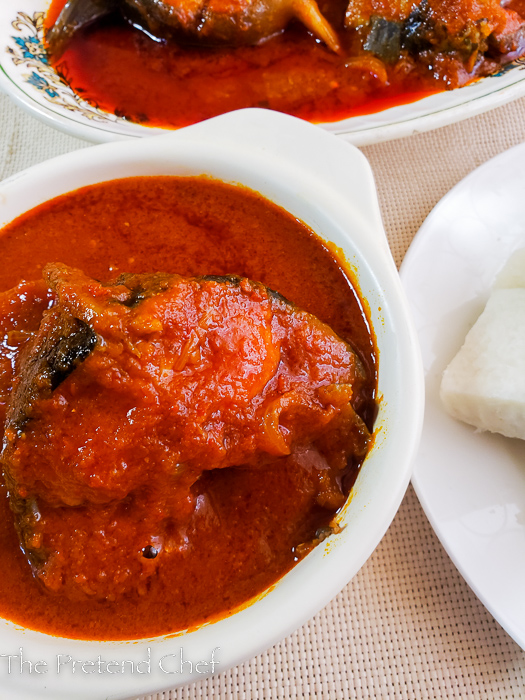
On the other hand, you can use mackerel, sardines, herring or any strong-flavoured fish if and only if you love the taste of the fish already.
Catfish has a sweet flavour profile so you might need to add a little bit more pepper to balance it out. It is also slimy and will need to be thoroughly cleaned before use. To learn How to clean a catfish Click. Even if you bought a live one, learn how to process it, click.
I like to make my Catfish stew in a large frying pan so that there will be enough space to move around the fish without it breaking. Also, catfish releases water as it cooks, so don’t add too much water initially to the stew.
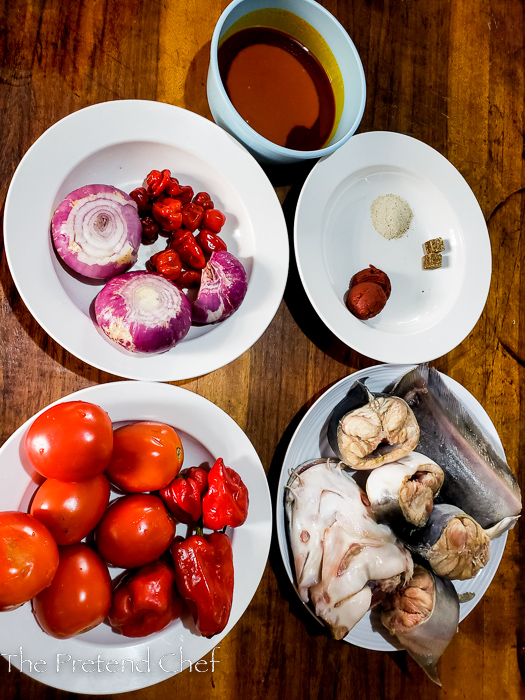
How to make Nigerian Catfish Stew
2 kg Catfish 6 tomatoes 6 Tatashe 8 Fresh pepper (Scotch Bonnet) 30g Tomato paste (Tin tomato) 3 medium onions 4 Seasoning cubes 2 teaspoons Fish seasoning
Clean, gut and wash fish, and cut into the desired size.
Place in a bowl of hot water and leave to stand for 1-2minutes.
Drain and rinse in cold water, set aside.
Slice one onion.
Place fish in a pot, sprinkle salt, 2 seasoning cubes and half of the sliced onions on it, and add 1 cup of water.
Place over medium-high heat and cook for 2 minutes, set aside.
Reserve the other half of the sliced onions.
Remove seeds from tatashe, wash two onions, tomatoes, tatashe and scotch bonnet.
Blend to a smooth puree.
Pour into a pot over medium heat and boil until well reduced.
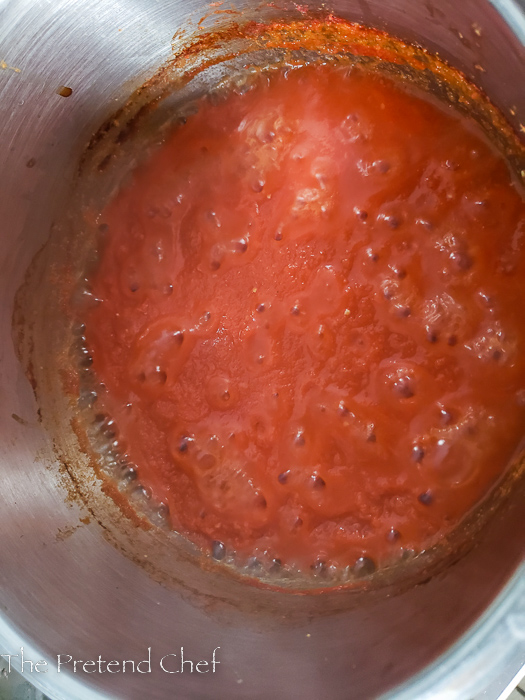
Pour palm oil/Vegetable oil into a dry frying pan or saucepan and set over medium-high heat.
When very hot, add the reserved sliced onions.
Fry until the onion softens and is translucent.
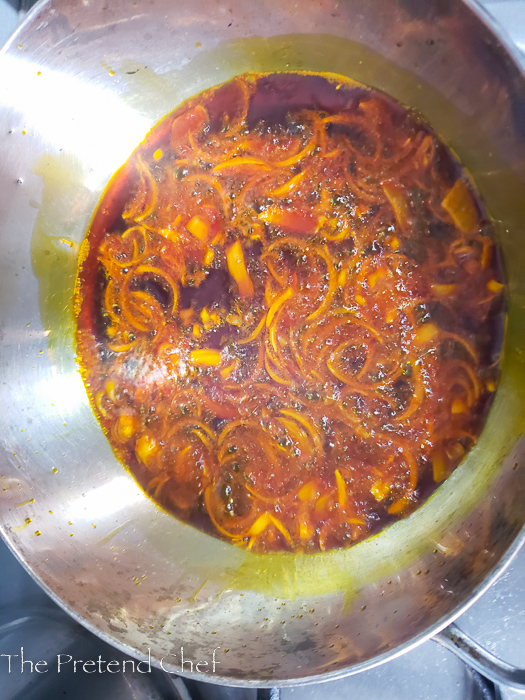
Add tomato paste, fry until it loses its rawness, about 3 minutes (taste it).
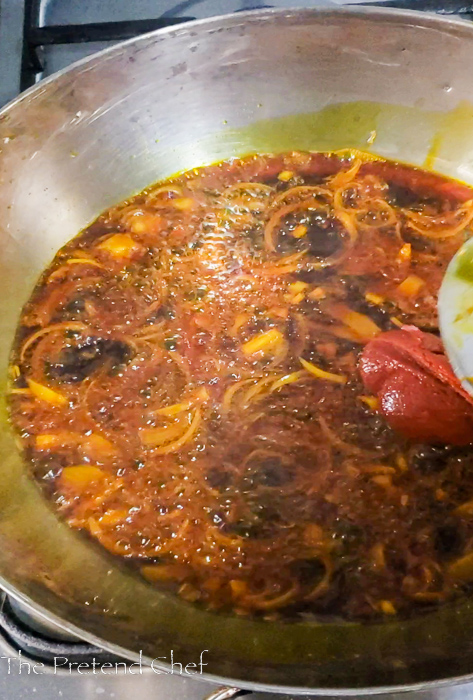
Pour in blended tomato, add seasoning cubes and salt, stir and leave to fry.
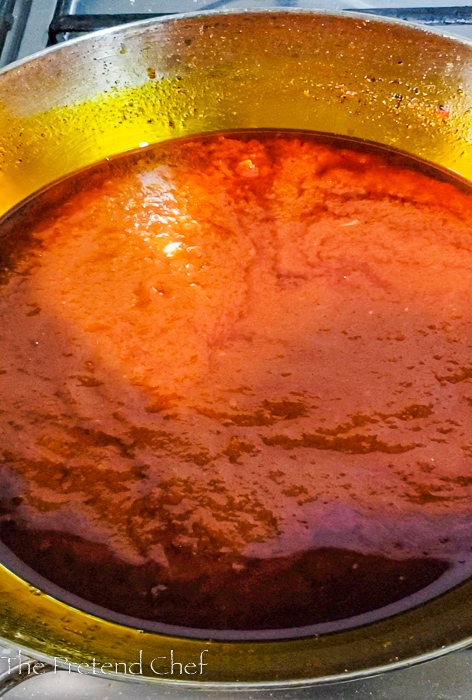
Stir and fry until the stew has reduced and some oil starts to float on top of the boiling stew, about 20 minutes.
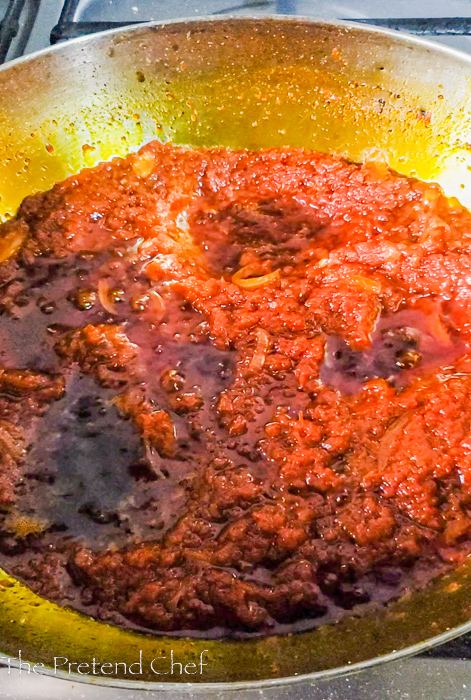
Add 1 cup of fish stock, stir and 1 cup of water.
Gently place the fish steaks in the stew, scoop the stew over it, and cover and cook the fish.
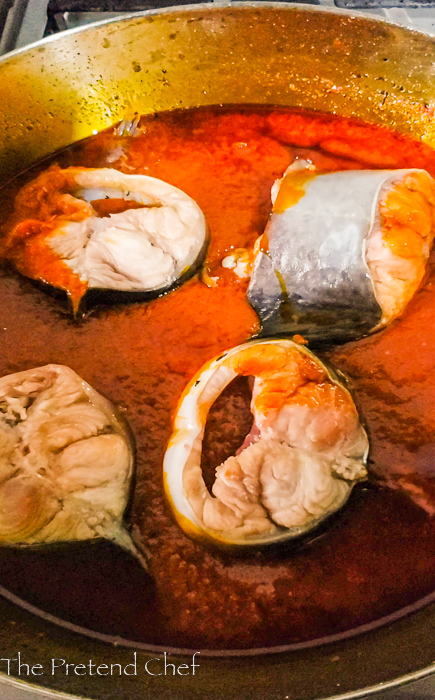
Gently shake and rotate the pot and push the fish in, submerging it in the stew, cover and cook until the fish has softened about 10 minutes.
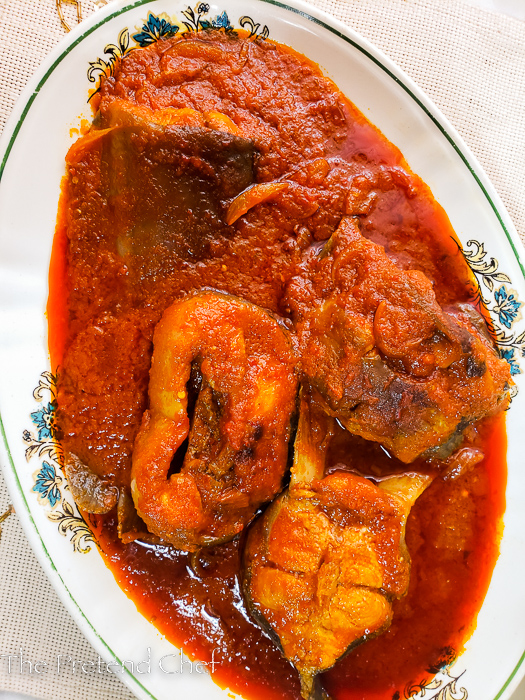
Taste and correct seasoning.
Take off the heat and enjoy.
Serve your Nigerian fish stew with boiled yam, plantain, sweet and Irish potato, and any fufu of your choice paired with some steamed vegetables e.g okro, ewedu (jute leaves), spinach etc.
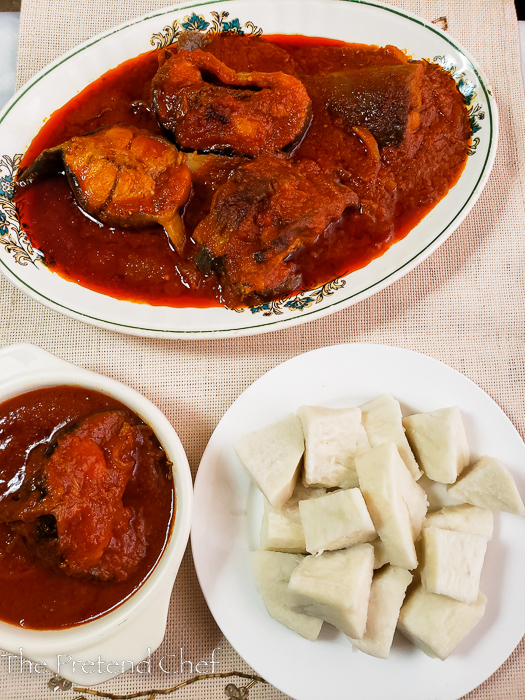
Note
- Do not bleach your palm oil, this stew needs the flavour of unbleached palm oil.
- When the tomato is poured into the hot oil, it will spit a lot, so be careful.
- Do not add too much water to the stew initially because fresh catfish will release some water.
- If the stew is way too light/watery, you can pick out the fish and give the stew a few more minutes of boiling, then put the fish back.
- Fish stew needs more seasoning than meat stew because meat produces a richer stock than fish.
- If using frozen fish, defrost fully before using. This also applies to the cooked stew, leave it to defrost fully in the refrigerator before reheating.
- If using croaker fish, remove scales, pour salt and rub in, then pour warm water over it. Leave to stand a few minutes, drain and rinse well in cold water.
- The pureed pepper should be very well pureed, if your blender isn’t powerful enough, use the commercial grinders in the market.
If you enjoyed my Nigerian Catfish Stew, you will also enjoy the Baked Catfish in Pepper sauce (point and kill), Catfish Peppersoup (Point and kill), Yam pepper soup (Ji mmiri oku), Foil baked fish with vegetables and Nigerian seafood chowder.
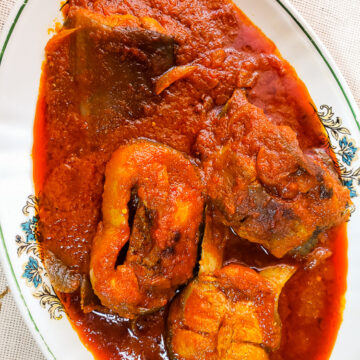
Nigerian Catfish Stew
Ingredients
- 2 kg Catfish
- 6 tomatoes
- 6 Tatashe
- 8 Fresh pepper (Scotch Bonnet)
- 30 g Tomato paste (Tin tomato)
- 3 medium onions
- 4 Seasoning cubes
- 2 teaspoons Fish seasoning
Instructions
- Clean, gut and wash fish, and cut into the desired size.
- Place in a bowl of hot water and leave to stand for 1-2minutes.
- Drain and rinse in cold water, set aside.
- Slice one onion.
- Place fish in a pot, sprinkle salt, 2 seasoning cubes and half of the sliced onions on it, and add 1 cup of water.
- Place over medium-high heat and cook for 2 minutes, set aside.
- Reserve the other half of the sliced onions.
- Remove seeds from tatashe, wash two onions, tomatoes, tatashe and scotch bonnet.
- Blend to a smooth puree.
- Pour into a pot over medium heat and boil until well reduced.
- Pour palm oil/Vegetable oil into a dry frying pan or saucepan and set over medium-high heat.
- When very hot, add the reserved sliced onions.
- Fry until the onion softens and is translucent.
- Add tomato paste, fry until it loses its rawness, about 3 minutes (taste it).
- Pour in blended tomato, add seasoning cubes and salt, stir and leave to fry.
- Stir and fry until the stew has reduced and some oil starts to float on top of the boiling stew, about 20 minutes.
- Add fish stock and water, stir.
- Gently place the fish steaks in the stew, scoop the stew over it, and cover and cook the fish.
- Gently shake and rotate the pot and push the fish in, submerging it in the stew, cover and cook until the fish has softened about 10 minutes.
- Taste and correct seasoning.
- Take off the heat and enjoy.
- Serve your Nigerian fish stew with boiled yam, plantain, sweet and Irish potato, and any fufu of your choice paired with some steamed vegetables e.g okro, ewedu (jute leaves), spinach etc.
Notes
- Do not bleach your palm oil, this stew needs the flavour of unbleached palm oil.
- When the tomato is poured into the hot oil, it will spit a lot, so be careful.
- Do not add too much water to the stew initially because fresh catfish will release some water.
- If the stew is way too light/watery, you can pick out the fish and give the stew a few more minutes of boiling, then put the fish back.
- Fish stew needs more seasoning than meat stew because meat produces a richer stock than fish.
- If using frozen fish, defrost fully before using. This also applies to the cooked stew, leave it to defrost fully in the refrigerator before reheating.
- If using croaker fish, remove scales, pour salt and rub in, then pour warm water over it. Leave to stand a few minutes, drain and rinse well in cold water.
- The pureed pepper should be very well pureed, if your blender isn't powerful enough, use the commercial grinders in the market.
Do you have any comments, questions or suggestions, please leave a comment below.
Share this recipe using the share buttons. Subscribe to the blog for instant notifications of new recipes.
Follow on Instagram: @thepretendchefofficial, Twitter: @thepretendchef Facebook: https://web.facebook.com/thepretendchef/ and Pinterest: https://www.pinterest.com/thepretendchef/

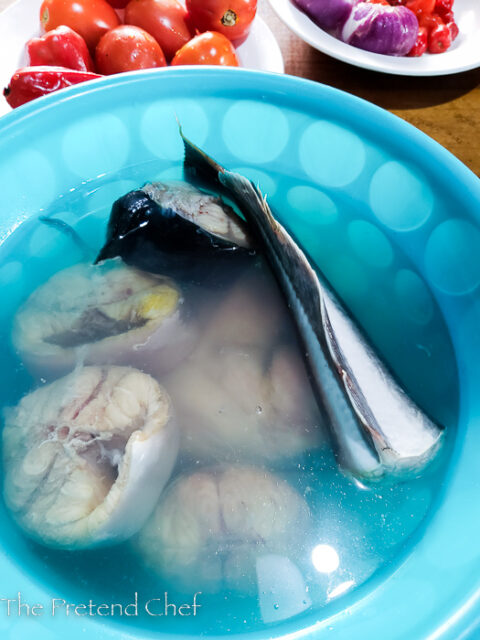
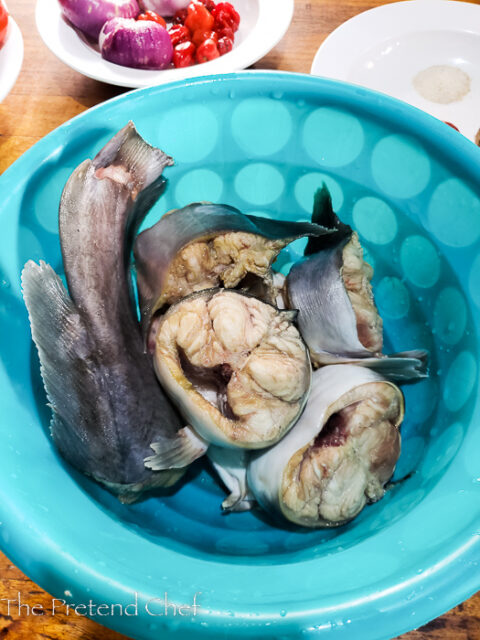
 I am Ganiru, a wife, a mother, a food blogger, a chef, an author and an accountant. I love to cook and write about food, especially Nigerian and afro-centric food...
I am Ganiru, a wife, a mother, a food blogger, a chef, an author and an accountant. I love to cook and write about food, especially Nigerian and afro-centric food...